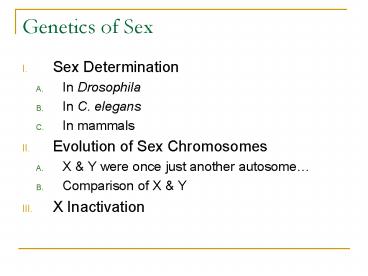Genetics of Sex PowerPoint PPT Presentation
1 / 20
Title: Genetics of Sex
1
Genetics of Sex
- Sex Determination
- In Drosophila
- In C. elegans
- In mammals
- Evolution of Sex Chromosomes
- X Y were once just another autosome
- Comparison of X Y
- X Inactivation
2
I. Sex determination mechanisms
- Although most animals have two sexes (M/F) there
is a great variety of mechanisms that have
evolved - GSD
- XA
- XX/XY
- ZW/ZZ
- ESD
3
Sex Determination A. in Drosophila
- Every cell determines its sex independently
- Ratio of X chromosomes to Autosomes is what
determines sex
4
Early in embryonic development, a cascade of
differential (alternate) mRNA splicing results in
either female or male.
- The three branches of the hierarchy govern
- X chromosome dosage compensation
- somatic sexual differentiation
- male sexual behavior
5
1
0.5
6
(No Transcript)
7
B. C. elegans hermaphrodites or males?
- Like Drosophila,
8
XA 1, enhanced expression of fox-1 sex-1
whose products inhibits the expression of xol-1.
sdc genes are expressed, which are involved in
dosage compensation and hermaphodite development.
9
C. Sex determination in mammals
- Not independent for each cell
- Not as simple a pathway as Drosophila or C.
elegans not yet completely understood - Sex is determined by the presence or absence of
the Y chromosome
10
Gonad is bipotential
- 3 cell lineages present in gonad as well as the
germ cells - Supporting cell lineage will give rise to Sertoli
cells in testis follicle cells in ovary - Steroidogenic cell lineage produce sexual
hormones - Each lineage has
11
Mammalian gonad forms within the developing
urogenital system, which itself derives from the
intermediate mesoderm. This is divided into 3
regions
Epithelial structures are shown in red,
mesenchymal structures are shown in blue, and the
striped region denotes the genital ridge. (WD)
Wolffian duct (MT) mesonephric tubules (MD)
Mullerian duct (UB) ureteric bud (CE) coelomic
epithelia.
12
Transcriptional control is mechanism for switch
13
(No Transcript)
14
II. Evolution of the X Y
A. X Y were once just another autosome
- Evolved 300 mya, autosomal origin
- X 1,098 genes (lowest compared to autosomes)
- 4,493 ECRs conserved between human, mouse, rat,
zebrafish pufferfish - Males Hemizygous
- X linked inheritance
15
Autosomal origin of X supported by orthologous
regions from Chicken, 30 regions of homology
illustrated
16
B. Comparison of X Y
- Y significantly smaller than X, few genes shared
between the two - In the Y chromosome, the shutting down of XY
crossing over during evolution triggered a
monotonic decline in gene function - PAR1 homology maintained by recombination in
male meiosis, genes in this region not subject to
dosage compensation
17
(No Transcript)
18
III. X Inactivation
- Dosage compensation mechanism in mammals
- Mammalian cells have ability to count their X
chromosomes - X inactivation center (Xic) plays critical role
- Xist (located in Xic) expression required for
compaction of X into a Barr body - X chromosomal controlling element (Xce) TsiX
affects the choice of which X to be inactivated - About 15 of the genes escape effects of X
inactivation - Xist
- Pseudoautosomal genes also found on Y
- Female sex-specific genes
http//www.hhmi.org/biointeractive/animations/x_in
activation/xinact_frames.htm
19
(No Transcript)
20
(No Transcript)

